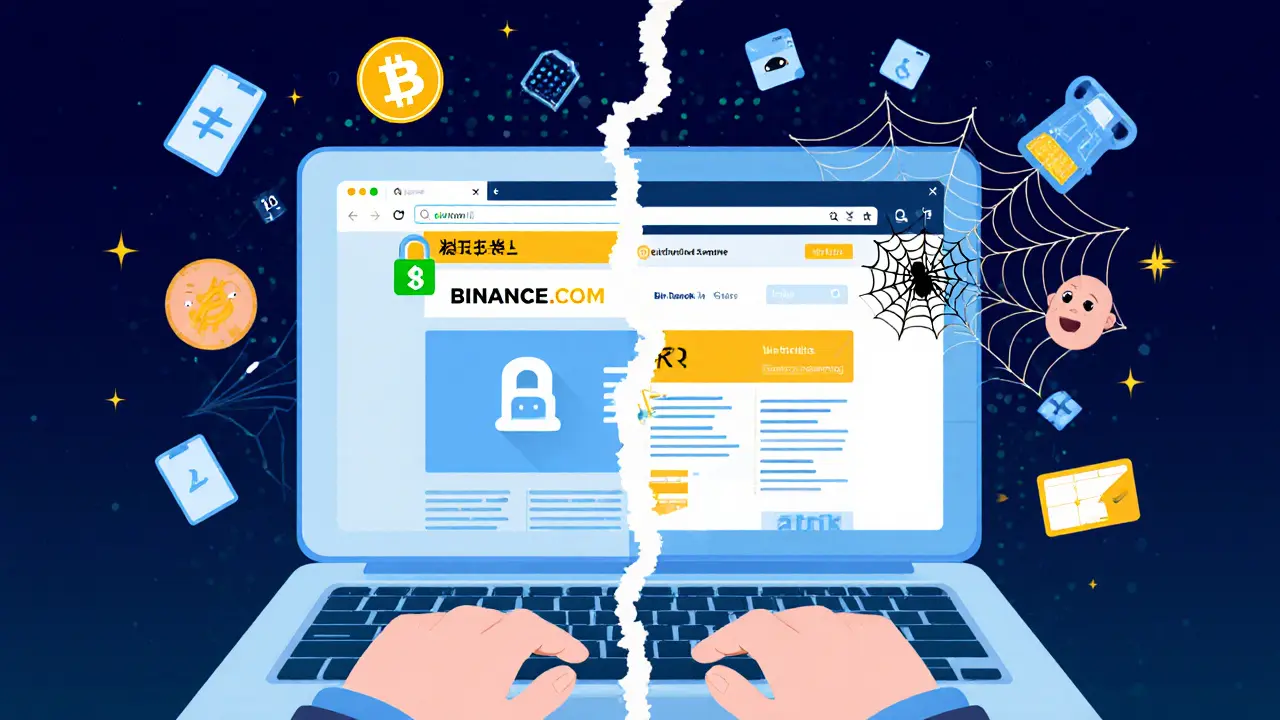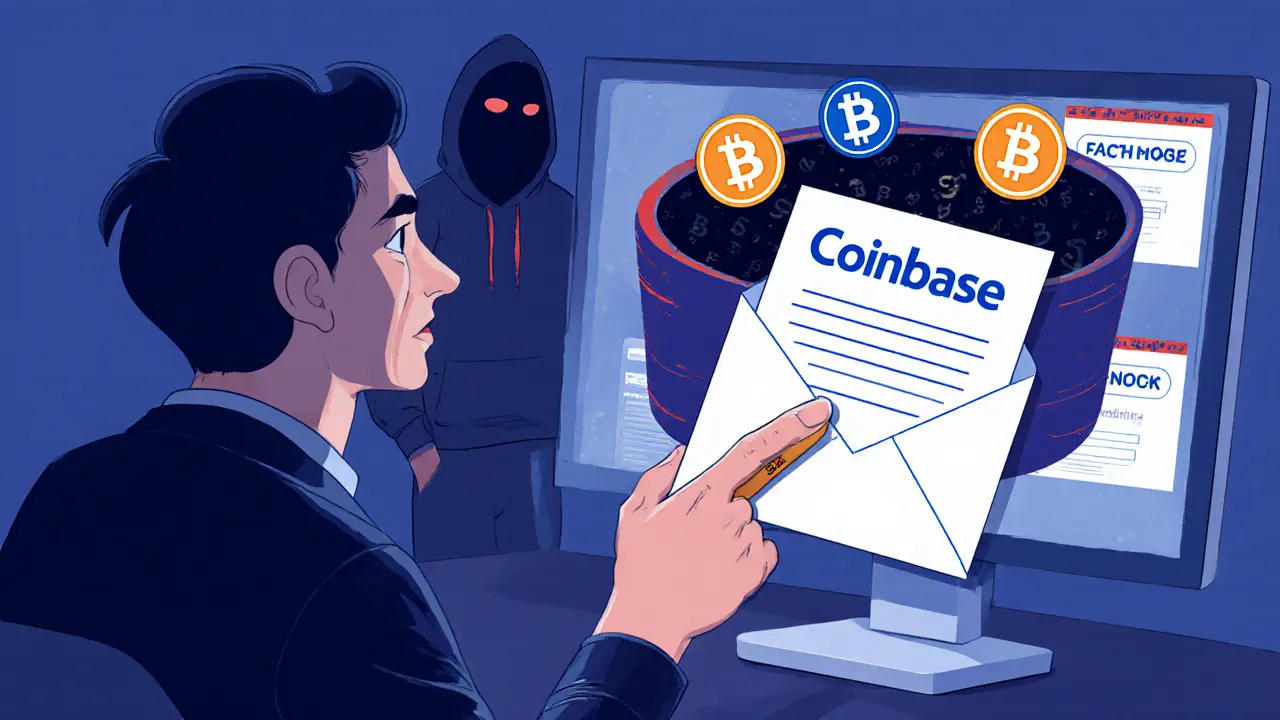Crypto Phishing Scam Checker
Check if a crypto URL is safe
Paste any cryptocurrency-related link to verify if it's legitimate. This tool checks for common phishing patterns based on the article's security guidelines.
How Crypto Phishing Scams Actually Work
Every day, people lose thousands of dollars to crypto phishing scams-not because they’re careless, but because the scams are designed to look exactly like the real thing. Attackers don’t need to hack your wallet directly. They just need you to hand over the keys yourself. That’s the brutal truth: cryptocurrency phishing works because it exploits trust, not technology.
Imagine getting an email that looks like it’s from Coinbase. It has the right logo, the right tone, even the right spelling mistakes that mimic real customer service. It says your account needs verification. Click the link, enter your recovery phrase, and boom-your entire balance vanishes. No password reset. No call from support. Just silence.
These scams aren’t random. They’re surgical. Attackers study your habits, your favorite exchanges, even the apps you use. They know you check your wallet on your phone before bed. They know you trust messages from people who sound like your crypto group chat buddies. They use that knowledge to make their lies feel real.
Common Types of Crypto Phishing Scams You’ll Actually See
Not all phishing scams are the same. Here’s what’s actually happening right now:
- Clone phishing: You get an email you’ve seen before-maybe from MetaMask or Trust Wallet-but the link is different. The sender’s address looks almost right: [email protected] instead of [email protected]. You don’t notice the tiny difference. You click. You lose.
- Pharming: You type in binance.com exactly as it should be. But your DNS got hijacked. You land on a perfect copy of Binance. Your login details? Taken. Your funds? Gone. You didn’t click a bad link. You did everything right-and still got burned.
- AI impersonation scams: You see a YouTube video of Elon Musk saying, “Send 0.1 ETH and I’ll send back 10 ETH.” It’s him. His voice. His face. It’s not real. It’s AI-generated. Thousands send money. No one gets anything back.
- Romance scams (“pig butchering”): You meet someone on a dating app. They’re charming, smart, into crypto. After weeks of talking, they show you a “secret” investment platform. You invest $500. You get a small return. You invest $5,000. Then the site crashes. They disappear. You realize you were never talking to a person at all.
- Wallet draining: You connect your wallet to a “free NFT drop” site. You approve a transaction that says “Grant access.” You think it’s normal. It’s not. That approval lets scammers drain every token in your wallet-Bitcoin, Ethereum, Solana, even your rarest NFTs-without ever asking for your password again.
- SIM swap: Someone calls your phone carrier, pretends to be you, and transfers your number to their device. Suddenly, your two-factor codes go to them. Your exchange account? Compromised. Your wallet? Empty.
Why These Scams Are So Hard to Spot
These aren’t clumsy Nigerian prince emails from 2005. Modern crypto phishing is professional. Some operations have teams: designers, copywriters, customer service actors, even tech support impersonators. They run fake websites with live chat. They answer questions like real companies. They even have refund policies-on paper.
And they know you’re tired. You’ve seen ten “urgent wallet update” alerts this month. You’ve clicked “ignore” on every one. So when the eleventh one comes, you think, “This must be real-I’ve been ignoring the rest.” That’s exactly what they want you to think.
They also use urgency. “Your account will be locked in 2 hours.” “Your airdrop expires in 15 minutes.” “Your transaction failed-click here to fix it.” That panic overrides your logic. Your brain doesn’t check the URL. It just wants the problem to go away.

How to Protect Yourself (No Tech Jargon, Just Real Steps)
You don’t need to be a hacker to stay safe. You just need to change a few habits.
- Never click links from emails, DMs, or texts-even if they look perfect. Type the exchange or wallet address into your browser yourself. Bookmark the real sites. Use those bookmarks.
- Always check the URL. Look at the domain. Is it metamask.io or metamask-safe.com? The .io is official. The .com is fake. Pay attention to the last part.
- Use a hardware wallet for anything over $1,000. Devices like Ledger or Trezor keep your private keys offline. Even if you click a phishing link, the hacker can’t touch your funds unless they physically have your device and your PIN.
- Turn off SMS two-factor. SMS is easy to hijack via SIM swap. Use an authenticator app like Authy or Google Authenticator instead. Better yet, use a security key like YubiKey.
- Never approve wallet connections unless you’re 100% sure. If a site asks you to “connect wallet” or “approve transaction,” pause. Go to the official website. Check their social media. Look up the site on Reddit or CryptoScamDB. If it’s not verified, walk away.
- Treat “free crypto” offers like spam. No one gives away ETH for sending ETH. If it sounds too good to be true, it’s a scam. Period.
- Use a separate wallet for trading. Keep your life savings in a hardware wallet. Use a small hot wallet (like Phantom or MetaMask) for trading. Limit exposure.
What to Do If You’ve Already Been Scammed
First: Breathe. Panic won’t help.
Once your crypto is sent, it’s gone. Blockchain transactions are irreversible. There’s no “cancel payment” button. But you can still act:
- Report it immediately. File a report with the FTC (U.S.) or your local cybercrime unit. Include transaction hashes, screenshots, and any communication you had.
- Alert the platform. If you gave your credentials to a fake exchange or wallet site, report the domain to the real company. They may be able to flag it.
- Change every password. Especially if you reused passwords on other accounts. Use a password manager.
- Monitor your accounts. Check your bank, email, and other crypto wallets for unusual activity.
- Don’t pay a “recovery service.” If someone contacts you offering to get your crypto back for a fee? That’s another scam. They’re just fishing for more money.

Real Stories, Real Losses
In March 2025, a Reddit user lost $28,000 after clicking a link in a DM that looked like a verified NFT project update. The site had the same logo, same fonts, same color scheme as the real project. They approved a “gas fee” transaction-and lost everything.
A couple in Texas lost $110,000 after being convinced by a fake crypto influencer on Instagram. They were shown fake screenshots of profits. They sent more money to “unlock higher returns.” By the time they realized it was fake, the account was gone.
These aren’t rare. In 2024, Chainalysis reported over $1.8 billion lost to crypto scams-80% of it through phishing and social engineering.
Final Reality Check
The biggest mistake people make? Thinking they’re too smart to get scammed. The truth? The best scammers don’t target fools. They target people who are careful, curious, and trusting. That’s you. That’s me. That’s everyone who uses crypto.
Security isn’t about being perfect. It’s about building habits that make you harder to fool. One wrong click can cost you everything. But if you follow even half of these steps, you’ll be safer than 90% of crypto users.
Don’t trust links. Don’t trust promises. Don’t trust urgency. Trust only what you verify yourself.
How do I know if a crypto website is real?
Always type the URL directly into your browser. Don’t click links from emails or messages. Check the domain carefully-official sites use .io, .com, or .org from verified companies. Look for HTTPS and a padlock icon, but remember: even fake sites can have those. The best way? Bookmark the real site and use only that. Cross-check with the company’s official Twitter or Discord-never trust links from there either. If in doubt, search for the site on CryptoScamDB or Reddit’s r/CryptoCurrency to see if others have reported it.
Can I get my crypto back if I get phished?
Almost always, no. Blockchain transactions are irreversible by design. Once the funds leave your wallet, they’re gone. Law enforcement can track the transaction, but they can’t reverse it or freeze the funds unless they seize the attacker’s wallet-which is rare. Your best move is to report the scam immediately and change all your passwords. Avoid any “recovery services”-they’re always scams too.
Is it safe to connect my wallet to new DeFi apps?
Only if you’ve done your homework. Many DeFi apps are legitimate, but scammers create fake ones daily. Before connecting your wallet, search for the app’s name + “review” or “scam.” Check if it’s listed on DeFiLlama or CoinGecko. Look at the contract address on Etherscan-real projects have verified contracts. Never approve a transaction unless you understand what it’s doing. If it says “approve unlimited,” that’s a red flag. You’re giving them permission to drain your entire wallet.
What’s the difference between phishing and a rug pull?
Phishing tricks you into giving up your keys or sending funds directly. A rug pull is when the creators of a crypto project disappear after collecting investor money. In phishing, you’re the target. In a rug pull, you’re one of many investors. Rug pulls often involve fake partnerships, inflated social media hype, and sudden withdrawal of liquidity. Both are scams, but rug pulls are more about deception over time, while phishing is about immediate trickery.
Should I use a hardware wallet?
If you hold more than $1,000 in crypto, yes. Hardware wallets like Ledger or Trezor store your private keys offline, so even if your computer or phone gets infected, your funds stay safe. They’re not foolproof-you still need to protect your recovery phrase and PIN-but they’re the strongest defense against phishing and remote hacks. For daily trading, use a small hot wallet. For long-term holding, keep it on hardware.












People Comments
I literally just got scammed last month 😭 I thought it was my MetaMask update... turned out it was a .com site. I’m so mad at myself but also so grateful I found this post. You’re right-no one’s too smart for this. Just keep checking URLs. 🙏
The fact that people still fall for this after two decades of internet scams is a testament to human gullibility not crypto's flaws. If you can't tell a .io from a .com you shouldn't be holding assets at all
It's not about being smart or dumb. It's about how deeply we trust systems that mimic trust. The scam doesn't exploit ignorance-it exploits the human need to believe in legitimacy. We want to believe Coinbase is emailing us. We want to believe Elon is giving away ETH. That’s the vulnerability. Not the tech.
Oh wow. So the solution is... to not be an idiot? Groundbreaking. I'm sure everyone reading this is just waiting for the 'how to not be gullible' seminar. 🙄
I really appreciate how you laid this out. I’ve had friends lose everything and I never knew how to explain it without sounding condescending. This is clear, calm, and actually helpful. Thank you.
I find it absolutely criminal that these scammers operate with impunity. The infrastructure behind these attacks is sophisticated-some even have call centers. And yet no one is held accountable. This isn’t just negligence. It’s complicity.
I used to think I was safe because I never clicked links. Then I got phished via a fake Discord DM that looked like a mod message. Turns out even the most cautious can be tricked. This list saved me from losing my whole portfolio. Thank you.
I don't understand why people even use crypto if they're this careless. If you can't protect yourself, maybe you shouldn't be involved. It's not rocket science.
OMG I CANNOT BELIEVE PEOPLE STILL FALL FOR THIS!!! I LOST MY ENTIRE LIFE SAVINGS TO A PIG BUTCHERING SCAM AND I STILL SEE NEW VICTIMS EVERY DAY!!! THEY’RE NOT JUST STEALING COINS-THEY’RE STEALING HOPE!!!
The architectural vulnerability here isn’t technical-it’s epistemic. We’ve outsourced trust to interface aesthetics and linguistic mimicry. The attack vector is cognitive bias amplified by UX design that mirrors institutional legitimacy. We’re not being hacked. We’re being narrated into compliance.
I swear every time I think I’ve seen it all another one pops up and I just... sigh. Like why does this keep happening? Why do we keep falling for the same script? It’s exhausting